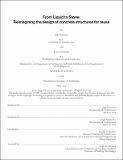From Liquid to Stone: Reimagining the design of concrete structures for reuse
Author(s)
Donovan, Inge; Schnitzler, Jenna
DownloadThesis PDF (144.2Mb)
Advisor
Mueller, Caitlin T.
Terms of use
Metadata
Show full item recordAbstract
Every year, 360 million metric tons of concrete construction waste are sent to landfill in the United States, in large part originating from the demolition of economically obsolete buildings. Meanwhile, global demand for new concrete is accelerating – in 2021, the production of new concrete was responsible for up to 9% of global CO2e emissions, and our dependence on concrete is only expected to rise over the next 50 years.
Concrete’s ubiquity is reinforced by its liquidity; it is simultaneously invisible and ever-present, undergirding global modernization through its cheap, local nature and its ability to take on any form in quick order. However, design with concrete has remained mostly unchanged, with inefficient, irreversibly fused structures cast in place to meet quickly changing programmatic needs, few of which survive longer than 30-50 years. Due to its careless application, concrete is perceived as a low-value material, and is therefore used wastefully, discarded quickly, and usually downcycled. The monolithic and inflexible nature of reinforced concrete structures perpetuate concrete’s culture of obsolescence and demolition.
To meet emissions targets and demand for building, we need to close the loop by developing a circular economy of structural materials. Instead of reusing salvage materials that have already entered the waste stream, this thesis confronts the design of new concrete structures directly, presenting the design of and methodology behind Pixelframe, a precast kit of parts for reconfigurable concrete structures. In a future where buildings are increasingly seen as stockpiles for subsequent reuse, the reinvention of concrete structures is an imperative that presents an opportunity for a new tectonic – concrete is no longer a liquid poured once and cured on site, but instead is a material more akin to stone, retaining value across multiple lifespans.
Date issued
2024-05Department
Massachusetts Institute of Technology. Department of ArchitecturePublisher
Massachusetts Institute of Technology